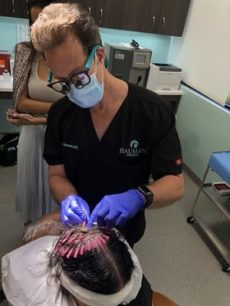DS Laboratories (the flagship brand of DS Healthcare) makes the well known Revita and Spectal DNC line of hair loss products. Men and women can both use these products.
Revita from DS Laboratories
 The most famous product from DS Labs is the Revita brand shampoo for hair growth stimulation. It contains several dihydrotestosterone blockers as well as ketoconazole, caffeine, and biotin. Make sure to also read my posts on natural DHT blockers and Revivogen shampoo and Nizoral shampoo.
The most famous product from DS Labs is the Revita brand shampoo for hair growth stimulation. It contains several dihydrotestosterone blockers as well as ketoconazole, caffeine, and biotin. Make sure to also read my posts on natural DHT blockers and Revivogen shampoo and Nizoral shampoo.
According to DS Healthcare, Revita combines antioxidant and anti-androgenic properties. It also contains powerful hydrating molecules, hair-growth stimulants, and amino acids. Around 1,900 Amazon reviews currently give the product an average rating of 4.1 out of 5 stars. The company also sells Revita conditioner.
Spectral DNC Hair Loss Products
DS Laboratories also makes the well known Spectral.DNC-N topical hair loss treatment. It contains the company’s proprietary Nanoxidil® alternative to Minoxidil (Rogaine). The product makes use of nanosome delivery technology. I have not read of any users claiming major side effects. However, please do your own research from reading many customer reviews.
According to the official product description:
The compounds used in Spectral.DNC-N have in clinical studies shown to open ion channels within cells; suppress dihydrotestosterone; prevent perifollicular fibrosis; provide antioxidant effects; prolong the anagen phase of hair follicles; increase expression of VEGF; suppress protein-kinase-C isozymes; and block chronic inflammation.
Other well known products sold by DS Laboratories include: the Spectral.CSF hair revitalizing treatment for women; and the Dandrene brand anti-dandruff shampoo.
Nanoxidil
Nanoxidil is a molecule that resembles Minoxidil, but supposedly causes fewer adverse reactions. It comes in a liposome formulation that contains a potassium channel opener, pyrrolidinyl diaminopyrimidine oxide, azelaic acid, lysophosphatidic acid and copper tripeptide-1. A 2008 study from South Korea found 5% Nanoxidil to benefit hair growth in mice via increased IGF-1 expression and decreased TGF-beta1 expression.
A 2018 study found that topical Spectral DNC-N (which contains Nanoxidil 5%) reduced hair shedding in women with female pattern hair loss. It also increased hair mass and density. One of the authors of this study is the well known hair loss research scientist Dr. Antonella Tosti.
DS Healthcare Patent
Last week, DS Healthcare Group filed its second patent (first one was filed in October 2013) related to a new proprietary topical hair loss treatment. From the news release regarding this development:
“This new patent addresses the composition and methods of a new compound described as a calcium-activated potassium channel opening agent for topical treatment of hair loss.”
According to the company’s (now former) CEO Daniel Khesin, this patent-pending molecule will produce better hair regrowth than topical minoxidil.
Update 2019: Ownership change in the Miami-based DS Labs. The CEO remains Dr. Fernando Tamez. Also note that DS Laboratories introduced a broad-spectrum CBD hair growth shampoo in 2019. The product is known as Revita CBD. It contains cannabidiol, a compound that is extracted from cannabis. Make sure to read my post on CBD oil, hemp and hair growth.
